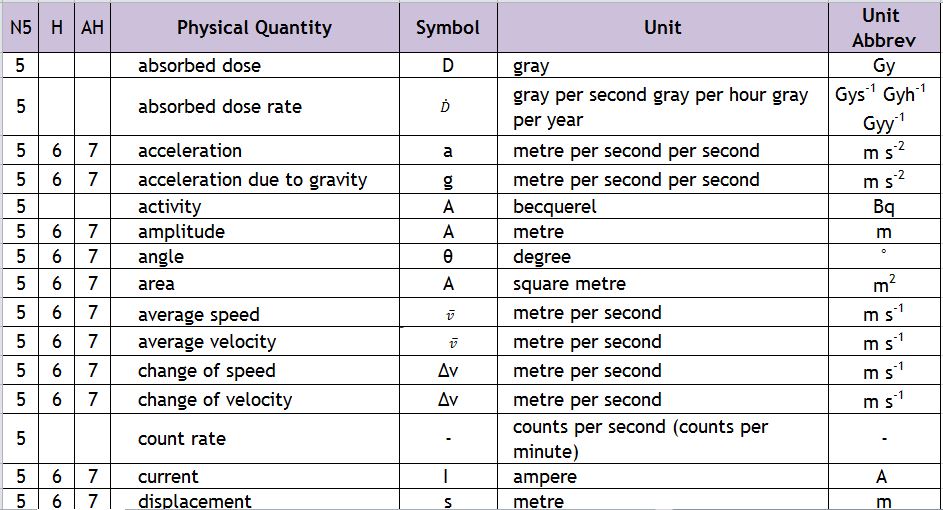| Trad | 2001 | 4 b | a (OR F) is directly proportional to -x
Usual now to use -y rather than -x |
| Trad | 2001 | 5 aii | (Electrostatic potential at a point) is the work done per unit charge moveing the charge from infinity to the point |
| Trad | 2001 | 11 a | electric field
vibrates in all directions in unpolarised light
vibrates in one plane only in polaried light |
| Trad | 2002 | 3 ci | velocity required by a body to escape earth gravitational field by reaching infinity |
| Trad | 2002 | 5 ai | diffraction pattern produced by electon beam |
| Trad | 2002 | 10 cii | wavelength has incerased therfore the source is moving away from the observer |
| Trad | 2006 | 3 ai | Force exerted on 1 kg (of mass) placed in the field |
| Trad | 2006 | 11 c | (Path length) in oil depends on angle of incidence or thickness ∴different colours are seen due to interference |
| Trad | 2009 | 8 b | One tesla is the magnetic induction of a magnetic field in which a conductor of length one metre, carrying a current of one ampere (perpendicular) to the field is acted on by a force of one newton. |
| Trad | 2009 | 9 ai | Division of amplitude is when some of the light reflects from the top of the air wedge and some is transmitted/refracted into the air. OR Some of the light is reflected from a surface of a new material/medium and some of the light is transmitted/refracted into the new material/medium. |
| Trad | 2009 | 10 a | A stationary wave is caused by interference effects between the incident and reflected sound. |
| Trad | 2009 | 10 b | The antinodes of the pattern are areas of maximum displacement/amplitude/disturbance The nodes of the pattern are areas of minimum/zero displacement/amplitude/disturbance |
| Trad | 2010 | 4 a | Total angular momentum before (an event) = total angular momentum after (an event) in the absence of external torques |
| Trad | 2010 | 6 bii | E-field is zero inside a hollow conductor. E-field has inverse square dependence outside the conductor. |
| Trad | 2010 | 11 a | unpolarised light => Electric field vector oscillates or vibrates in all planes polarised light => Electric field vector oscillates or vibrates in one plane |
| Trad | 2014 | 3 ai | The (minimum) velocity/speed that a mass must have to escape the gravitational field (of a planet). |
| Trad | 2014 | 4 ai | The unbalanced force/ acceleration is proportional to the displacement of the object and act in the opposite direction. |
| Rev | 2014 | 4 aii | The distance from the centre of a black hole at which not even light can escape. or The distance from the centre of a black hole to the event horizon. |
| Trad | 2014 | 5 di | Electron orbits a nucleus / proton , Angular momentum quantised or Certain allowed orbits / discrete energy level |
| Rev | 2014 | 6 aii | Photoelectric effect or Compton scattering Collision and transfer of energy |
| Rev | 2014 | 6 di | Electron orbits a nucleus / proton (1) Angular momentum quantised (1) or Certain allowed orbits / discrete energy level |
| Rev | 2014 | 8 a | The unbalanced force/ acceleration is proportional to the displacement of the object and act in the opposite direction. |
| Trad | 2014 | 11c | Wavelengths in the middle of the visible spectrum not reflected or destructively interfere. Red and blue reflected / combined to (form purple). |
| Trad | 2014 | 13 aii | The brightness would gradually reduce from a maximum at 0 degrees to no intensity at 90 degrees. It would then gradually increase in intensity from 90 degrees to 180 where it would again be at a maximum |
| Rev | 2015 | 1 c | The speed of the mass will be less. Second mark for correct justification. eg: Flywheel has greater moment of inertia Flywheel will be more difficult to start moving Smaller acceleration of flywheel More energy required to achieve same angular velocity. |
| Rev | 2015 | 2 a | Massive objects curve spacetime Other objects follow a curved path through this (distorted) spacetime |
| Rev | 2015 | 2 c | Time passes more slowly at lower altitudes (in a gravitational field).
or
Lower gravitational field strength at higher altitude. |
| Trad | 2015 | 3 biii | Potential is work done (per unit mass) moving from infinity to that point. or Infinity defined as zero potential. Work will be done by the field on the mass. or A negative amount of work will be done to move an object from infinity to any point. or WD by gravity in moving to that point or Force acts in opposite direction to r. |
| Rev | 2015 | 5 aiii | Difficult scale to read/information from diagram can only be read to 1 s.f. |
| Rev | 2015 | 6 ai | Force acting on (acceleration of) object is directly proportional to and in the opposite direction to its displacement. (from equilibrium) |
| Rev | 2015 | 7 aii | l reduced (or f increased) for X-rays or >E transferred
D x reduced for X-rays
since D x D p ³ h/4 p
D p increases |
| Rev | 2015 | 7 b | since DEDt³ h/4 p
Borrowing energy for a short period of time allows particles to escape |
| Rev | 2015 | 8 ai | Two sets of coherent waves are necessary (for an interference pattern) or (Interference patterns can be produced by) Division of wavefront. |
| Rev | 2015 | 9 ai | Force acts on particle at right angles to the direction of its velocity/motion or a central force on particle. |
| Rev | 2015 | 9 b | (Component of) velocity at right angles to field/ v sin θ, results in circular motion/central force. (Component of) velocity parallel to field/ v cosθ is constant/no unbalance force (in this direction). |
| Trad | 2015 | 9 bi | Magnetic fields/induction are equal in magnitude (½) and opposite in direction |
| Rev | 2015 | 10 ai | Force exerted per (unit) charge is constant at any point in the field |
| Rev | 2015 | 10 aiv | Any suitable answer eg Systematic uncertainty in measuring d or V Alignment of metre stick The flame has a finite thickness so cannot get exactly to the zero point. Factors causing field to be non-uniform. A p.d. across the resistor for all readings. Poor calibration of instruments measuring V or d. |
| Rev | 2015 | 10 b | Deflection is less. E is less. Force/acceleration is less |
| Rev | 2015 | 12 biii | Rate of change of current/magnetic field is at its maximum |
| Trad | 2016 | 5 ai | Frames of reference that are accelerating (with respect to an inertial frame) |
| Trad | 2016 | 5 aii | It is impossible to tell the difference between the effects of gravity and acceleration. |
| Trad | 2016 | 8 aii | The precise position of a particle/ system and its momentum cannot both be known at the same instant. OR If the uncertainty in the energy of the
particle is reduced, the minimum
uncertainty in the lifetime of the
particle will increase (or vice-versa). |
| Trad | 2016 | 10 ai | displacement is proportional to and in the opposite direction to the acceleration |



